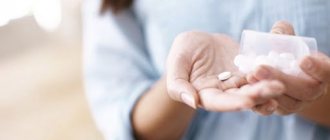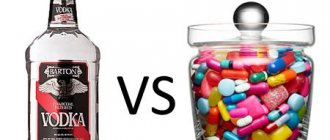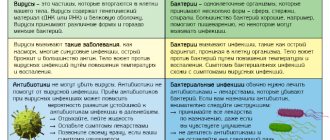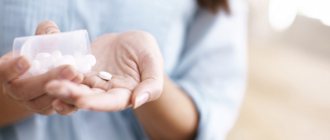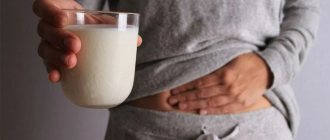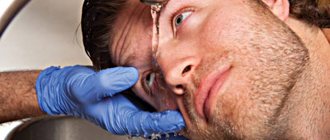Cold season means not only tea with honey, but also a course of antibiotics for various infections. Such a course can often harm the digestive system, although it helps to heal. Doctors prescribe medications that soften the effects of antibiotics, but we can additionally help our gastrointestinal tract and introduce probiotic foods into our diet, which will help revive the beneficial bacteria in our intestines. Please note that the tips and list of useful products below do not replace the recommendations of your doctor and in no way replace the medications prescribed to you. They can only help you recover faster from illness.
What should you eat during and after a course of antibiotics, and what is better to exclude, says Anna Ivashkevich, nutritionist, clinical psychologist-dietitian, member of the National Association of Clinical Nutrition :
“We all know that antibiotics have a strong effect on the microflora of our intestines; they literally kill both the bad and the good. To minimize the likelihood of side effects, you need to eat a certain type of diet and include foods that contain probiotics, fiber and inulin in your diet. These substances are needed to maintain a good balance of bacteria in the body.
During a course of antibiotics
The most beneficial probiotic is sauerkraut. We add baked apples, kefir, homemade yogurt, and sour cream to the same list.
Important! Pay attention to the expiration date of all fermented milk products. It should not be more than 2 weeks.
Jerusalem artichoke, bananas, onions and garlic will help create a favorable atmosphere. These are prebiotic products that improve intestinal microflora. But you need to be careful not to introduce more than 8-10 g of each product per day into your diet. Recommendations may vary in each specific case, everything is individual and depends on how severely the digestion is impaired.
Protector against colds. 7 simple foods rich in zinc Read more
What are antibiotics
Antibiotics are a huge group of drugs that are united by their effect on bacteria. They can act in different ways: destroy the cell membrane in bacteria, disrupt metabolic processes in them, etc. But the result is always the same: the bacteria loses the ability to maintain its vital functions and dies.
Such drugs are certainly useful in situations where harmful bacteria cause illness and even threaten life. But, alas, antibiotics do not have a selective effect and they act with the same “killing power” on both pathogenic and beneficial microorganisms. For example, those that populate the intestinal or oral mucosa and form local immunity.
After completing the course
When antibiotic treatment is completed, it is necessary to help the body cope with its consequences. Here we also need probiotic products that improve digestion.
I would advise you to include several products from the list in your diet, you can do everything:
- sauerkraut;
- artichokes;
- spinach;
- whole grain cereals;
- yoghurts, but always natural, without adding toppings;
- kefir;
- heat-treated fruits and vegetables;
- Brussels sprouts;
- parsley;
- sea buckthorn
I will highlight sea buckthorn berries separately. When used correctly and in moderation, this product normalizes the digestive system, improves metabolism, helps in the treatment of ulcers and gastritis, and relieves heartburn. You can brew teas with berries, make compotes or jelly from sea buckthorn.
You can drink 1 tbsp of sea buckthorn oil at night. l. as a medicine. It will help heal and restore the intestines.
Seasonal product. How to properly prepare rose hips Read more
Medicines and products: how to combine correctly?
text: Irina Chepaikina
Expert
Irina Marchenko,
Candidate of Pharmaceutical Sciences,
pharmacist
It turns out that we can significantly speed up our recovery if we take into account the compatibility of medications and food. At the same time, unsuccessful combinations can completely neutralize the effect of the drugs and even seriously harm your health. It is very important to choose the right diet when using medications. After all, our body is a large biochemical laboratory.
Dangerous ties
Let's start with the most famous example of adverse drug-food interactions. We are talking about drugs from the group of monoamine oxidase inhibitors, which are often prescribed to treat depression. In this case, you should temporarily avoid avocado, chocolate, bananas, red wine, cheese, soy and smoked products. The fact is that the listed products contain tyramine, which, under the influence of monoamine oxidase, is converted into an inactive form and accumulates in the body. This leads to increased blood pressure and a severe headache. Another extremely undesirable combination is milk and vitamin D. Dairy products promote the absorption of drugs based on this vitamin, which poses a danger to the central nervous system.
When taking diuretics, you need to keep in mind that some of them help remove potassium from the body. This is dangerous for the heart and can cause arrhythmia. During treatment with these drugs, dried fruits (dried apricots, figs) and bananas are very useful, because they contain a lot of potassium.
If your doctor has prescribed anticoagulants to prevent blood clots, try to eat less Brussels sprouts, cauliflower, liver, soy, walnuts and zucchini. All these products contain quite a large amount of vitamin K, which acts directly opposite to anticoagulants, bleeding may occur.
Grapefruit can be called the king of incompatibility. There are so many drugs with which it “conflicts” that some researchers advocate special labeling of products containing this fruit. The fact is that certain components of grapefruit juice block the CYP3A4 enzyme, which is involved in the metabolism of many modern drugs. Thus, the concentration of the drug in the blood may become unacceptably high, which is fraught with various complications. Even one grapefruit can increase the toxicity of antibiotics, enhance the effect of benzodiazepine sleeping pills, and lead to a sharp decrease in blood pressure in people taking antihypertensive drugs. The latter, however, mainly applies to drugs from the nifedipine group.
It is also not recommended to combine grapefruit juice with potency enhancing drugs due to possible increased toxicity. The same applies to statins - drugs that lower blood cholesterol levels. But don't despair if you really love grapefruits. One glass of juice or half a piece of fruit will not do any harm in most cases, although it is best to consult a doctor before starting treatment.
Exclude
While taking antibiotics and recovering from the course, you should exclude from your diet:
- grapefruit;
- alcohol;
- yeast and sugar (this means that you will have to give up flour products and sweets).
These products, firstly, interfere with the proper absorption of antibiotics, and can also cause nausea, abdominal pain and even heart rhythm disturbances. Antibiotic treatment can cause a yeast infection (candidiasis), and baked goods and sweets can make things worse.
Diet while taking antibiotics
The human body is a complex multifunctional system in which all parts are interconnected. Therefore, during drug therapy, special attention is paid to the patient’s nutrition, and taking antibiotics is no exception. But how are food and medicine related? If you take antibiotics in tablet form, they enter the digestive tract, where the dissolution process occurs. During its course, the active substances enter the blood and are carried throughout the body, providing a therapeutic effect. The better the drug is absorbed, the stronger its effect. But sometimes it happens that for some reason the absorption process is disrupted, the speed of passage of the drug through the sections of the digestive tract decreases, and then its effectiveness decreases.
To avoid this, it is recommended:
- do not overuse very fatty foods - they retain drugs in the stomach, and when they enter the intestines, they already lose their therapeutic effect;
- eat protein foods in moderation - with excessive consumption, there is an additional load on the liver and kidneys, which is already quite strong during antibacterial therapy. As a result, the intestinal microflora suffers, and many complain of constipation, bloating and other unpleasant symptoms after a course of antibiotics. However, protein deficiency should not be allowed, as this reduces the effectiveness of treatment. In a word, the golden rule of moderation works flawlessly here too;
- completely eliminate alcohol - absolutely everyone knows about this rule, but few understand the meaning of this prohibition. Let's be honest: only a very few drugs are completely incompatible with alcohol, but among them, for example, metronidazole and erythromycin, which are quite common in Russia. When taking them, you should absolutely not drink, otherwise vomiting, nausea, tachycardia, and headaches will not take long to occur. In other cases, nothing particularly terrible will happen, for example, from one glass of good wine, but it is not recommended to actively lean on such drinks. Alcohol puts a fairly large load on the liver and kidneys, which already work very intensively during drug therapy, so is it worth testing their strength? In no case should you take the tablets with alcohol: it can change the binding of the active substances of the drug to blood proteins. If you can’t do without strong drinks, take your medications 2-3 hours before the feast;
- follow the rules of administration (according to the instructions from the manufacturer or the attending physician) - carefully observe the dosage, frequency of use and other nuances. It is best to take the tablets with regular drinking water.
Before using antibiotics, you must consult a specialist!
The information provided is for informational purposes only. If you have any health problems, first of all, you should seek advice from a specialist.
← Previous articleNext article →
How to determine the presence of antibiotics in milk
A truly accurate determination of antibiotics in milk can only be carried out using special test kits. The principle of operation of the test kit is based on competitive immunochromatographic determination of the presence of antibiotic residues, and can be designed to detect one specific antibiotic or several at the same time.
At home, the only available way to find out how safe the milk you buy is to conduct a ripening test. To do this, add one spoon of sour cream to a small amount of milk, then put the milk in a warm place. If there are no antibiotics in it, after a few hours (about 2 to 4), it will turn into yogurt. If the milk does not ferment at all or acquires a slimy and unpleasant consistency, something (and most often antibiotics) is preventing the normal fermentation of the milk.
Types of antibiotics
There are hundreds of different types of antibiotics, but most can be roughly divided into six groups:
- Penicillins are widely used to treat various infections: skin, respiratory system, urinary tract.
- Cephalosporins are used to treat a wide range of serious infections, including sepsis and meningitis.
- Aminoglycosides are prescribed mainly in hospitals (outpatient - under the strict supervision of a doctor) for the treatment of severe pathologies. This group of drugs can cause serious side effects: hearing loss and kidney pathology. Aminoglycosides are used, usually in the form of injections or eye/ear drops.
- Tetracyclines are used to treat a wide range of infections: skin (severe forms of acne and rosacea), urogenital.
- Macrolides are prescribed for infectious processes in the lungs and/or as alternative drugs for patients with allergies to penicillin. They are also used to treat penicillin-resistant strains of bacteria.
- Lincosamides are effective in the treatment of infectious bone lesions.
Treatment
People who are faced with intestinal dysbiosis due to antibiotic therapy are recommended to eat dietary table No. 4 according to Pevzner, which helps to normalize the motor-evacuation function of the large intestine and reduce the intensity of fermentation and putrefactive processes in the lumen of the gastrointestinal tract. The daily diet includes foods rich in plant fiber, as well as fermented milk products that contain bifidum and lactobacilli.
Correction of the microflora composition is carried out using antibacterial agents that are not absorbed into the systemic circulation (Rifaximin). Also, intestinal antiseptics (Nifuroxazide) are widely used. To restore the balance of the intestinal microbiota, the following groups of drugs are used:
- Probiotics (preparations containing cultures of beneficial intestinal microorganisms).
- Prebiotics (substances that stimulate the growth and reproduction of normal intestinal microflora).
- Synbiotics (complex preparations containing both beneficial microorganisms and a nutrient substrate for them).
The newest and most effective way to restore microflora after taking antibiotics is to take metaprebiotics, which contain a nutrient medium for intestinal microflora (fructopolysaccharides and fructooligosaccharides), as well as calcium lactate, which stimulates the reproduction process and growth of beneficial bacteria in the intestine. To confirm the effectiveness of metaprebiotics in the fight against dysbiosis, a comparative experiment was conducted, during which the metaprebiotic Stimbifide Plus and other drugs used to restore microflora after antibiotics . Maximum effectiveness was proven with the metaprebiotic Stimbifid Plus, which in a short period of time helped restore the required amount of its own bifidobacteria living in the lumen of the gastrointestinal tract. Compared to other drugs containing probiotics and prebiotics, the metaprebiotic Stimbifide Plus has the following advantages:
- To restore the intestines after antibiotics, it can be used simultaneously with antibacterial agents from the first day of taking them.
- Helps effectively restore the human intestinal microflora.
- Does not cause adverse reactions.
- Equally effective and safe for people of any age.
- It has a beneficial effect on the condition of the gastrointestinal tract along its entire length.
- Reduces the intensity of the inflammatory process that can develop with dysbacteriosis.
- Helps speed up the process of natural restoration of the epithelium of the gastrointestinal mucosa.
If we talk about what to drink with antibiotics to restore microflora , then the metaprebiotic Stimbifide Plus is the best choice
How do antibiotics get into milk?
Animals, just like people, suffer from infectious diseases. And they also need treatment. Therefore, the detection of antibiotics in milk, even in high concentrations, is normal if the dairy cow has recently been treated with these drugs. But such milk cannot be used for the manufacture of dairy products. It is allowed as a raw material when the concentration of the antibiotic in milk is reduced to hundredths or even thousandths of a percent (depending on the drug used for treatment). Antibiotics are also sometimes used as a preventative measure when there is a possibility of mass infection of the herd during epidemics.
Milk that goes on sale can retain up to 90-100% of the antibiotics present in it at the time of milking, of course, if such milk is accepted at the factory. This is due to the fact that antibacterial substances are practically not destroyed and do not transform into other forms during sterilization and pasteurization.
In fermented milk products, milk with antibiotics is technologically unacceptable. And it’s not even about the special scrupulousness of manufacturers, but about the undesirable effect of antimicrobial agents: in their presence, fermentation does not occur at all or occurs incorrectly. Accordingly, if the concentration of antibiotics in whole milk is incorrectly determined and it enters the production line for cheeses, yoghurts, etc., then the entire batch may be unsuitable. Therefore, a high-quality test for antibiotics in milk protects not only the health of consumers, but also the economic stability of the enterprise.
What antibiotics can be found in milk
Antibiotics in milk are represented by absolutely all drugs of this group that are used in veterinary medicine. These are penicillin, syntomycin, tetracycline, various cephalosporins, etc. - in general, more than 70 items.
Most often, broad-spectrum antibacterial drugs are used in veterinary practice. Such antibiotics are among the most effective for mixed infections (which is often observed in farm animals), but they are also among the most dangerous when it comes to the consequences.
How to take antibiotics correctly
It is important to take antimicrobial medications correctly to prevent the development of resistance, a condition where a strain of bacteria no longer responds to treatment with one or more types of antibiotics. Therefore, self-medication in the case of antibiotics is not just harmful to health - it is dangerous!
Only a doctor should decide on the advisability of prescribing an antimicrobial agent, select a specific drug, dosage and determine the duration of use.
Antibiotics should be used strictly in the doses prescribed by the doctor. Oral forms (tablets, capsules, syrups) are drunk in accordance with the recommendations prescribed in the instructions: before/after meals. You cannot reduce or increase the dosage on your own: a low level of the active substance in the blood will not have the desired effect, and an excessive one will increase the risk of side effects.
It is very important to drink the entire prescribed course of antibiotics, even if the temperature has subsided and your health has improved. Stopping use risks the emergence of resistant forms of bacteria. You cannot skip taking the next dose: the effect of the medicine must be continuous, that is, one portion of the substance “clings” to another. Interruptions in admission are unacceptable. If you accidentally miss one dose, drink the medicine “as soon as you remember”, and then continue the course as usual. Do not take a double dose to make up for a missed dose.
